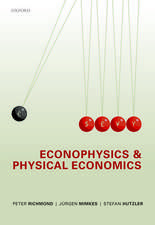A New Direction in Mathematics for Materials Science: SpringerBriefs in the Mathematics of Materials, cartea 1
Autor Susumu Ikeda, Motoko Kotanien Limba Engleză Paperback – 18 dec 2015
The middle part of the book describes mathematical ideas and methods that can be applied to materials problems and introduces some examples of specific studies—for example, computational homology applied to structural analysis of glassy materials, stochastic models for the formation process of materials, new geometric measures for finite carbon nanotube molecules, mathematical technique predicting a molecular magnet, and network analysis of nanoporous materials. The details of these works will be shown in the subsequent volumes of this SpringerBriefs in the Mathematics of Materials series by the individual authors.
The posterior section of the book presents how breakthroughs based on mathematics–materials science collaborations can emerge. The authors' argument is supported by the experiences at the Advanced Institute for Materials Research (AIMR), where many researchers from various fields gathered and tackled interdisciplinary research.
Preț: 380.49 lei
Nou
Puncte Express: 571
Preț estimativ în valută:
72.82€ • 75.74$ • 60.11£
72.82€ • 75.74$ • 60.11£
Carte tipărită la comandă
Livrare economică 11-17 aprilie
Preluare comenzi: 021 569.72.76
Specificații
ISBN-13: 9784431558620
ISBN-10: 4431558624
Pagini: 86
Ilustrații: X, 86 p. 38 illus., 4 illus. in color.
Dimensiuni: 155 x 235 mm
Ediția:1st ed. 2015
Editura: Springer
Colecția Springer
Seria SpringerBriefs in the Mathematics of Materials
Locul publicării:Tokyo, Japan
ISBN-10: 4431558624
Pagini: 86
Ilustrații: X, 86 p. 38 illus., 4 illus. in color.
Dimensiuni: 155 x 235 mm
Ediția:1st ed. 2015
Editura: Springer
Colecția Springer
Seria SpringerBriefs in the Mathematics of Materials
Locul publicării:Tokyo, Japan
Public țintă
ResearchCuprins
1. Introduction2. Emergence of the research field Materials Science (e.g., the first Department of Materials Science at Northwestern University in 1959 by integration of related field of metallurgy, polymer science, solid state physics, and so on)3. Influence of mathematics on materials science in history (e.g. group theory and crystallography)4. Mathematical tools for materials science and specific example of research5. Promoting mathematics- science collaboration in Japan.
Caracteristici
Covers rather broad aspects of history in a concise manner based on the interaction between mathematics and materials science Contains important modern mathematical technologies promising for future math–materials Surveys several key fundamental mathematical results that have strongly influenced the development of materials science Includes supplementary material: sn.pub/extras

















